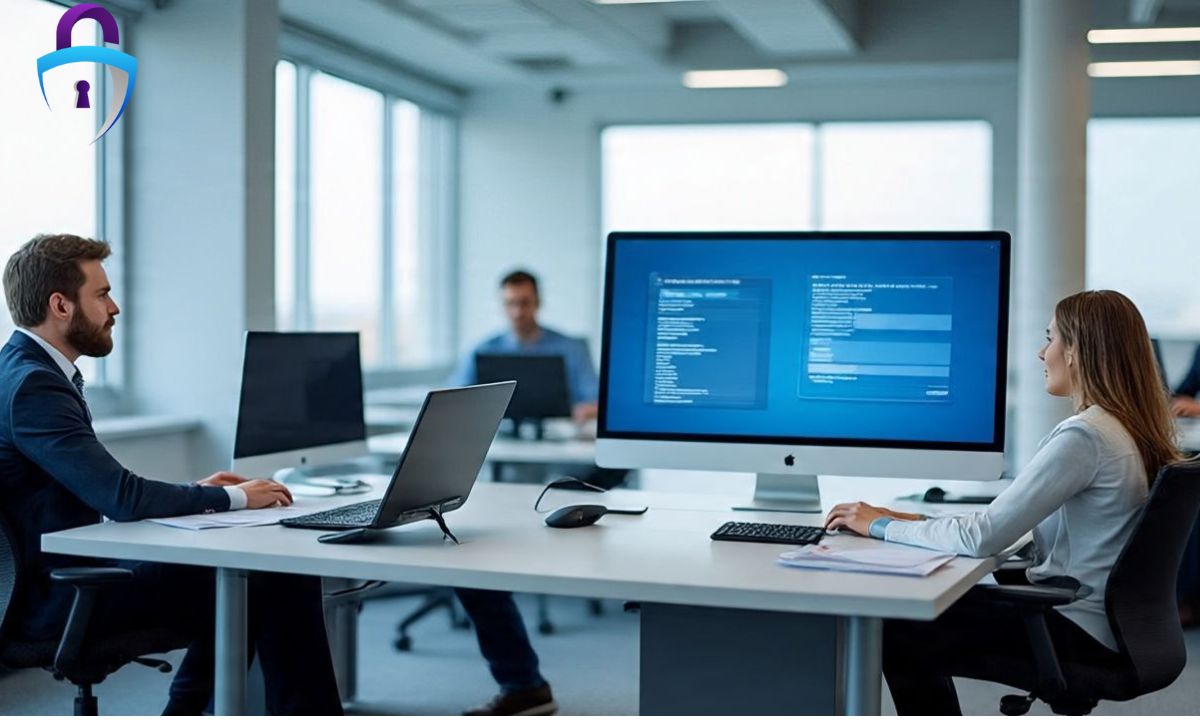When choosing an employee monitoring tool, it’s important to find one that is easy to use. Look for features that track work activity without being too intrusive. Good tools should offer real-time monitoring to help managers stay updated.
Privacy settings are essential to protect employee rights. The tool should also provide clear reports to analyze productivity. Lastly, it must be reliable and secure to keep data safe.
🚀 Creative Name Generator
Group Names
Sports Teams
Game Names
School Names
Business Names
Fantasy Teams
Select a category to generate names
Employee Monitoring Software Overview
In today’s fast-evolving workplace, where remote and hybrid work models are increasingly prevalent, businesses face new challenges in managing and optimizing workforce productivity. Employee Monitoring Software has emerged as a critical solution to these challenges, offering organizations
The ability to track and analyze employee activities during work hours. This type of software provides valuable insights into how employees spend their time, which tasks they complete, and what resources they utilize, whether employees are working in-office or remotely.
Key Features of Employee Monitoring Software
When selecting an employee monitoring tool, it’s essential to focus on features that will directly contribute to your company’s operational success. Below are the key functionalities to prioritize:
1. Time Tracking
Time tracking is the foundation of most employee monitoring systems. This feature records the amount of time an employee spends on various tasks or projects. Beyond facilitating accurate payroll processing, time tracking allows managers to analyze how work hours are allocated across responsibilities, helping to identify productivity patterns and inefficiencies.
2. Screen Monitoring
Screen monitoring enables real-time viewing or periodic screenshots of employee computer screens. This feature helps managers verify that employees are focused on work-related activities during their designated hours.
It also acts as a deterrent against unauthorized or non-productive behavior, providing a transparent overview of digital workspaces.
3. Activity Logging
Activity logging tracks the applications, websites, and software an employee uses throughout the day. By monitoring software usage, organizations can ensure that employees are leveraging approved tools and not engaging in distracting or prohibited activities.
4. Reporting and Analytics
Robust reporting and analytics transform raw monitoring data into actionable insights. These tools generate detailed reports on employee performance, time allocation, task completion, and other relevant metrics.
Managers can use these reports to identify bottlenecks, allocate resources more effectively, and customize training programs to address skill gaps.
5. Alerts and Notifications
Some monitoring tools offer customizable alerts that notify managers about suspicious or unauthorized activities, such as access to restricted websites or data transfers. This real-time notification system helps maintain security and ensures swift responses to potential issues.
6. Privacy Controls and Compliance Features
Leading software solutions incorporate privacy settings to safeguard employee rights and comply with data protection laws like GDPR. Features might include the ability to mask personal information, restrict monitoring to work hours, and provide transparency by informing employees of what data is collected.
7. Integration Capabilities
Seamless integration with existing business tools—such as payroll, human resources, project management, and communication platforms—ensures efficient workflows and prevents data silos. Integration enhances the utility of monitoring software by aligning it with broader organizational processes.
8. User-Friendly Interface
The software should be intuitive and easy to navigate for both managers and employees. Clear dashboards, straightforward reporting tools, and simple configuration options reduce the learning curve and improve adoption rates.
Benefits of Employee Monitoring Software
Implementing employee monitoring software delivers advantages that benefit both employers and employees.
For Employers:
- Increased Productivity: Managers gain visibility into how employees use their work time, allowing them to address inefficiencies, streamline workflows, and ensure that critical tasks are prioritized.
- Improved Security: Monitoring tools can detect unauthorized data access or risky behaviors, protecting sensitive company information and reducing the risk of data breaches.
- Cost Savings: By minimizing idle time and optimizing resource allocation, businesses can reduce operational costs and maximize output from their workforce.
- Enhanced Remote Workforce Management: With the rise of remote work, monitoring software ensures that remote employees remain engaged and productive without constant supervision.
- Data-Driven Decisions: Analytics enable informed decisions regarding hiring, training, and project management, boosting overall organizational performance.
For Employees:
- Self-Assessment and Accountability: Monitoring encourages employees to stay focused, promoting a sense of responsibility and ownership of their work.
- Transparency: Clear communication about monitoring helps build trust, as employees understand expectations and the rationale behind oversight.
- Performance Improvement: Access to personal productivity data enables employees to identify strengths and areas for growth, fostering professional development.
- Flexible Work Support: Monitoring tools support flexible work arrangements by ensuring accountability without intrusive micromanagement.
Compliance and Privacy Concerns

While employee monitoring offers significant business benefits, it also raises valid concerns about employee privacy and data protection. Striking a balance between effective oversight and respecting employee rights is essential.
Legal Compliance
Companies must adhere to relevant data protection regulations, such as the General Data Protection Regulation (GDPR) in Europe or the California Consumer Privacy Act (CCPA) in the United States. These laws govern how employee data can be collected, stored, and used, imposing strict requirements on transparency and consent.
Ethical Monitoring Practices
- Transparency: Employees should be informed clearly about what data is collected, how it will be used, and the benefits of monitoring.
- Purpose Limitation: Monitoring should focus solely on work-related activities during business hours, avoiding intrusion into personal time.
- Data Minimization: Collect only the data necessary to achieve legitimate business goals.
- Access Control: Limit access to monitoring data to authorized personnel to prevent misuse.
- Regular Reviews: Monitor policies and software configurations regularly to ensure compliance with evolving laws and ethical standards.
Building Trust
Open communication and involvement of employees in the monitoring process help foster trust and acceptance. When employees understand that monitoring is designed to support their productivity and security—not to spy on them—they are more likely to engage positively with these tools.
Real-World Use Cases
Employee monitoring software is versatile and finds applications across numerous industries and business models:
Remote Work Environments
In fully remote or hybrid workplaces, managers lack physical oversight, making digital monitoring tools essential for maintaining visibility into employee productivity. These tools help track progress on tasks, ensure deadlines are met, and support engagement without micromanagement.
Project-Based Industries
Businesses that operate on project timelines, such as software development, consulting, or marketing, use monitoring software to track time spent on specific deliverables. This insight helps identify workflow bottlenecks, optimize team assignments, and ensure projects stay on budget and schedule.
Customer Service and Call Centers
Monitoring tools track call times, breaks, and software usage to optimize staffing, improve customer service, and maintain regulatory compliance.
Manufacturing and Logistics
In industries where both digital and physical workflows are involved, employee monitoring software can integrate with operational technologies to ensure adherence to safety protocols and efficiency standards.
Choosing the Right Employee Monitoring Tool
Selecting an effective employee monitoring tool requires a strategic approach:
1. Scalability
Choose software that can scale alongside your company’s growth. Small businesses might need basic time tracking and activity logging, while larger enterprises may require advanced analytics, AI capabilities, and multi-department support.
2. Feature Set Alignment
Match the software features with your specific business needs. For example, prioritize screen monitoring for high-security environments or focus on integration with project management tools for task-heavy industries.
3. User Experience
A user-friendly interface encourages adoption by managers and employees alike. Look for customizable dashboards, easy-to-understand reports, and clear setup procedures.
4. Compliance and Security
Ensure the software complies with relevant data privacy laws and offers robust security measures, including data encryption and access controls.
5. Integration Capabilities
Check for compatibility with existing systems like payroll, HR, communication tools, and productivity platforms to streamline workflows.
6. Vendor Reputation and Support
Choose vendors with proven track records, positive customer reviews, and strong customer support services to facilitate smooth implementation and ongoing use.
Implementation Best Practices
Effective implementation is critical for maximizing the benefits of employee monitoring software while minimizing resistance and privacy concerns:
1. Communicate Clearly
Before deployment, explain the purpose, benefits, and scope of monitoring to all employees. Emphasize that the goal is to enhance productivity and security—not to micromanage or invade privacy.
2. Involve Employees
Seek employee input and feedback to foster acceptance and address concerns. Transparency about the process builds trust.
3. Provide Training and Support
Offer comprehensive training sessions and accessible support resources to help users understand how to utilize the software effectively.
4. Define Policies
Establish clear monitoring policies detailing what activities are monitored, how data will be used, and employees’ rights. Make these policies readily available.
5. Monitor and Adjust
Regularly review monitoring data and processes to identify opportunities for improvement. Adapt settings to align with evolving business needs and employee feedback.
6. Respect Privacy Boundaries
Ensure monitoring is limited to work-related activities and adheres strictly to agreed policies and legal requirements.
Trends and Future Outlook

The employee monitoring landscape is rapidly evolving, driven by technological advances and changing work models:
AI-Powered Monitoring
Artificial intelligence and machine learning are transforming monitoring by enabling predictive analytics, anomaly detection, and behavior pattern recognition. AI can identify potential productivity issues or security risks proactively.
Enhanced Analytics
Future tools will offer deeper, real-time analytics with more intuitive visualizations, helping managers make faster and more informed decisions.
Integration with Collaboration Tools
As hybrid and remote work become standard, monitoring tools will increasingly integrate with collaboration platforms to track teamwork dynamics and project progress.
Privacy-First Design
Software vendors are focusing on building privacy-enhanced monitoring solutions that balance oversight with employee rights, complying with stricter global data protection standards.
Mobile and Cross-Platform Monitoring
With the rise of mobile and flexible devices, employee monitoring tools are expanding capabilities to track productivity across multiple platforms seamlessly.
Frequently Asked Questions
What is employee monitoring software?
Employee monitoring software is a tool used to track and record employee activities during work hours to enhance productivity and security.
Is employee monitoring legal?
Yes, as long as it complies with data privacy laws and employees are informed transparently about the monitoring.
How does screen monitoring work?
Screen monitoring captures real-time views or screenshots of employee computer screens to ensure work-related activities.
Can employee monitoring software integrate with other business tools?
Most modern monitoring tools offer integration with payroll, project management, and communication platforms for seamless workflow.
How do companies address privacy concerns with monitoring?
By being transparent about data collection, limiting monitoring to work-related activities, and complying with legal standards like GDPR.
Conclusion
Employee Monitoring Software is a vital tool for modern businesses seeking to optimize productivity, enhance security, and maintain compliance in an increasingly digital and remote work environment.
When selecting a monitoring solution, companies should prioritize features such as time tracking, screen monitoring, activity logging, and advanced analytics, while ensuring privacy and ethical considerations are addressed.

James Anderson expert at GoNamePro, crafting unique group, sports, game, and school names to inspire creativity and identity.






